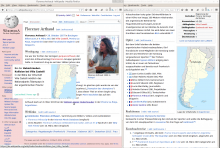This is a long-standing and extremely popular feature request, I'm surprised that I don't find a report. Please merge any duplicate.
Template:Location_map (https://www.wikidata.org/wiki/Q5625881) and friends use a manually-crafted SVG map and add a manually-centred point marker to show the location on the map of the page subject. Apart from its huge maintenance cost for editors and imperfect coverage, this system doesn't work reliably outside of desktop browsers (see blocked tasks).
All SVG locator maps (thousands, used in about a million articles) and maps of country subdivisions (over 600k files) should be replaced by maps dynamically generated from a map server / tileserver based on coordinates and perhaps another parameter.
Priority set to high as there is an entire team working on maps.wikimedia.org, presumably for this very purpose.
I discovered on https://lists.wikimedia.org/pipermail/maps-l/2015-November/001443.html that a new extension was created: https://www.mediawiki.org/wiki/Extension:Kartographer . The extension page doesn't clearly mention this use case, which however seems implied by some of the bullets. Maps maintainers are kindly asked to move this from MediaWiki-extension-requests to Maps (Kartographer) once the component is created, if this use case falls within the scope of the extension.
